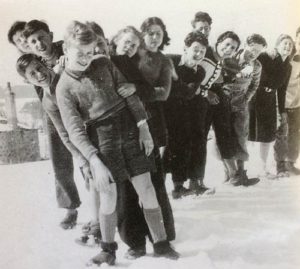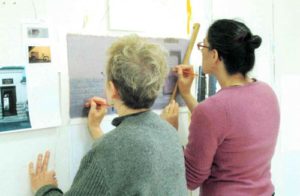EDUCATORS
Collaborations
Writing and illustrating with a partner to create “The Grand Mosque of Paris” and writing and researching in collaboration for “Hidden on the Mountain” and “Peter’s War”
I love working collaboratively with other writers and illustrators. Several of my books were written and illustrated with my long-time collaborator Deborah Durland DeSaix. Together, we researched and wrote Hidden on the Mountain; Deb had the idea for The Tree, which I wrote and she illustrated; we researched, wrote and illustrated The Grand Mosque of Paris together. We have a new book out, Peter’s War, which we wrote together, with Deb as the illustrator. We have many more projects in mind. Stay tuned!
Many people ask us what it’s like to work in collaboration. Here’s a Q&A we wrote for our book Hidden on the Mountain.
1. How did you come to write this book about Le Chambon-sur-Lignon?
Deb first learned about Le Chambon when she and her soon-to-be-husband took a trip to France in 2002. In a tiny museum in the center of town, a local historian described to them the dramatic World War II story of rescue and refuge that had taken place there, how the local farmers and villagers had all come together to help save the lives of around 3,500 Jews, most of them children. Deb came home and told me about what she had learned, and she asked me to collaborate with her on a book. We were awed and moved by this story. We tried to imagine what the refugees must have gone through and what their lives must have been like. We wanted to learn more and we definitely wanted to tell this story to others.
2. How did you approach your research?
We were interested in the real stories of the refugees and the people who helped them. We decided to find people who had been hidden in Le Chambon as children, interview them and tell their stories, rather than simply writing a historical overview. But it wasn’t easy tracking them down! After the war, they had scattered and could be living anywhere in the world. We started out with a good, old-fashioned approach: we went to the public library. Our research there turned up a documentary film about Le Chambon called “Weapons of the Spirit.” We contacted the film director and he put us in touch with some people, who in turn led us to others. We did online searches, read numerous books, even checked the phone book! Eventually, we located and contacted around thirty people—former refugees, rescuers, Resistance fighters, historians and others.
Most of the people we contacted were happy to be interviewed. A few were reluctant at first, but only one refused to be interviewed altogether. We travelled to meet them in New York, Florida, Virginia, Switzerland and all over France—thank goodness we both speak French!—where they welcomed us into their homes and entrusted us with memories of a very traumatic time in their lives. It was an amazing experience to hear these stories firsthand. We felt truly privileged.
3. How do you two work together? Did you write separately and then come together? Did you each take a section to work on?
As we did our research, it never occurred to us to think about how we would actually write the book together. When the time came, we sat down at the computer, side by side, and began. Karen did the actual typing, because she was faster. We spoke the book out loud, making changes as we went. When we finished that first chapter, we weren’t sure who had thought of which sentences. We’re lucky because we have a similar sense of language and how to tell a story and our differences complement each other. Along the way, we used the bartering system to reconcile our grammatical preferences—Deb wanted more contractions and Karen favored fewer commas. It all worked out in the end.
Since we were then living over 800 miles apart, we wrote during visits to each other, whenever we could. This was no hardship as we were such close friends and tried to visit each other as often as possible, even when we weren’t writing a book together. We wrote the entire book in this way, sitting side by side. Later, we discovered speakerphones, so we were able to edit and write together at our respective computers, typing simultaneously. This was before Skype and Google docs enabled us to talk to each other from afar while editing and writing in the same document—something we have been able to use for subsequent books.
4. What was the most interesting or surprising information you learned during your research?
 The risks that were taken by the people of Le Chambon, the generosity and bravery in the face of such grave danger, were astounding. Yet they did it unassumingly, as they felt it was the right thing to do to protect these refugees. After the war, they seldom talked about what they had done, even with their own children. It’s rare to find such instances of selflessness in today’s world.
The risks that were taken by the people of Le Chambon, the generosity and bravery in the face of such grave danger, were astounding. Yet they did it unassumingly, as they felt it was the right thing to do to protect these refugees. After the war, they seldom talked about what they had done, even with their own children. It’s rare to find such instances of selflessness in today’s world.
Also, we were surprised to learn that an American woman was a hero in the French Resistance in the Le Chambon region. Virginia Hall worked for the British secret service and the OSS, despite the fact that she had a wooden leg! The Gestapo tried in vain to catch her. In fact, she was on their most-wanted list. We spoke with people who knew her and worked with her in the Resistance. Her life was filled with dangerous exploits and intrigue. We’ve thought of writing a book about her, and there’s a chapter about her in Karen’s upcoming book, Surprising Spies (Summer 2019).
5. Tell us how you came to interview Elisabeth.
When we first began our research, as we were tracking down former refugees, one of our sources gave us Elisabeth’s name and urged us to contact her immediately. She said that Elisabeth was gravely ill, but was feeling somewhat better at that moment. We interviewed her within the month. Sadly, Elisabeth died six months later. She was the first person we interviewed for our book. Despite the fact that she was so ill, she graciously welcomed us into her home and told us her dramatic story. She even sang a little song for us, the prayer of thanks that had been sung every evening in the home where she lived in Le Chambon. We will always remember her.
6. What do you want readers to take away from this book?
We hope that the true stories in our book will allow readers to see life through the eyes of these brave young Jewish refugees, and to understand the magnitude of the gift of hope they received from the people of Le Chambon.
When we think of the Holocaust, we usually think in terms of numbers and statistics: six million Jews murdered, etc. But the Holocaust was not about numbers and statistics. It was about people and the ways in which their lives were shattered. In a world that was filled with conflict, intrigue, terror, danger and loneliness, it really came down to this: Every single act of kindness made a huge difference to someone.
The people of Le Chambon chose to act with kindness. Choosing to act with humanity and courage in the face of a nightmare made all the difference. We, too, can make these choices. It’s entirely up to each of us.

